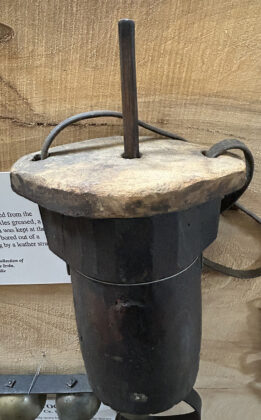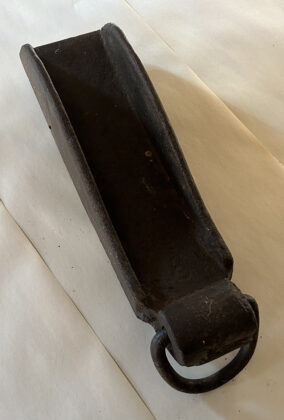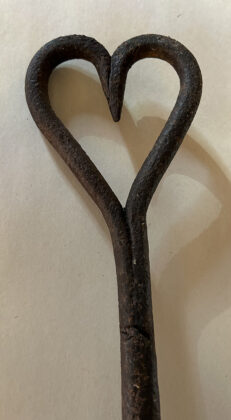
In the last column, readers were introduced to the Conestoga wagon, tens of thousands of which in the early 1800s moved families across the Allegheny Mountains to the great Ohio Country beyond. If you regard that vehicle as a tool, it would have been something of a Swiss Army knife. The Conestoga wagon virtually bristled with an array of special tools and accouterments designed to get it to its intended distant destination.
Wagon jack
Most notable among these tools was the wagon jack. Because a Conestoga wagon had to have all of its wheels removed every 100 miles so that the hubs and axles could be re-coated with grease, the jack was an indispensable tool. Because such wagons traveled an average of 15 miles a day, greasing the wheels was a weekly chore.
Construction of this wagon jack was a joint effort involving both a blacksmith and carpenter or cabinetmaker. The business end of the jack was a thick, heavy iron bar that had one edge with deep notches, which were integrated with a hand-crank mechanism into cogs that lifted and lowered the bar. A C-shaped piece of iron designed to go underneath the axle and hold it in position was attached on top of the bar.
The bar and hand-crank were housed in an attractively crafted heavy wooden case, its corners typically chamfered to allow it to be more comfortably gripped by the user. The bottom of the jack was equipped with multiple short iron spikes that stuck in the ground and stabilized the jack while in use. The wooden case always had heavy iron bands around the top and bottom to prevent it from splitting.
Today, Conestoga wagon jacks have transcended their original mundane purpose and have become elevated to the level of collectible American folk art, owing to the efforts of the blacksmiths who created them.
Using various kinds of metal stamps, the blacksmiths usually decorated the upper portion of the lift bar with motifs that ranged from stars, crescent moons, arrows and geometric designs of many kinds. These designs were clustered around the largest element, which was the year in which the jack was crafted. The jacks were often painted the same red color as the vehicle’s wheels, though occasionally other colors were used. The handles which cranked the jack mechanism were sometimes given decorative twists as well.
Hames bells

The next tool most commonly identified with the Conestoga wagon was the hames bells. Each animal pulling the wagon had a set of brass bells, suspended from a wrought iron frame attached to the hames on its harness. Hames are wooden or metal bars attached to the collar.
As the wagon jostled along the trail, these bells jangled loudly, alerting any oncoming wagons to its presence. It was said that regular drivers along the trail often knew what wagon was approaching by the particular sound of its bells. These sets of bells, which were probably imported from Switzerland, could range from the very simple to elaborate arrangements, sometimes topped by a fancy leather awning to keep water off them.
A tradition of Conestoga wagon culture was that if a teamster broke down along the trail and required the assistance of another waggoner to get going again, he had to surrender a set of his bells to the good Samaritan. The tradition of “knights of the road” among modern teamsters grew out of this practice of helping fellow travelers. Also, the oft-voiced phrase “I’ll be there with bells on” derived from this practice. Even today, this means “I’ll arrive with no breakdowns or problems.”
Tar bucket
Another piece of standard equipment carried aboard the Conestoga wagon was the tar bucket, which was suspended from the body above the rear axle. The bucket, usually little more than a reamed-out piece of log with a wooden lid, held the tar or grease that was used to lubricate the wheel hubs. The handle of a small wooden applicator protruded through the top of the bucket.
Wheel chock
Also carried aboard the wagon was a wheel chock to prevent the vehicle from rolling forward or backward if it had to park on an incline. The chock was usually a wedge-shaped block of wood from which protruded a handle to help set it into place under the wheel. On its underside, the chock usually had a heavy iron plate fitted with multiple sharp iron spikes to keep it anchored in the ground.
Drag shoe
A cast iron device called a “drag shoe” was also standard equipment. This heavy curved shoe, about a foot in length, fit over the iron wheel rim and was designed to help supplement the wagon’s brakes in slowing the vehicle as it traveled down a grade so that it wouldn’t run over the team pulling it. The drag shoe was held in place during the descent by a rope attached to it.
Hammer pin
The doubletree was attached to the singletrees to which the horses nearest the wagon were hitched. The doubletree was connected to the wagon by a heavy iron pin that passed through an iron doubletree hasp. This iron pin had a hammer head on top of it, and the bottom of the pin was beveled to form a screwdriver. It was probably the first multi-tool on the frontier.
Stay chain
Also standard on the exterior of the Conestoga wagon was a wrought iron holder for an axe which might be needed at any time to help clear a fallen tree or defend against predators. Additionally, a wrought iron stay chain was always carried to tie up the wagon and team when stops along the road were required. These masterpieces of wrought iron work were fashioned so that at least three links had to be broken before the chain was severed.
Tool boxes
The real masterpiece of the blacksmith’s art, however, was revealed in the hinges that secured the slanted lid of the toolbox that was always attached to the wagon’s side. These hinges were highly detailed and often incorporated such designs as tulips, hearts, birds, flower blossoms and snakes.
Few intact Conestoga tool boxes with outstanding ironwork survive today, and when they come on the market command eye-popping prices. One such box sold at a prestigious Pennsylvania auction house in 2018 for a gavel price of $19,000. Various other Conestoga hooks, chains, levers and locks that incorporate similar folk motifs also command high prices.






















Another great and informative article! Thank you!
A diagram with these tools and where they were placed would be helpful for those of us who need more of a visual aid to be able to understand how these tools were stored and used on the wagons.